Packed with the flavor and nutrition of whole grain flour and sourdough, this fresh milled sourdough bread is long-fermented and easy to prepare. Enjoy its deliciously tender crumb toasted and spread with butter or as your everyday sandwich bread.
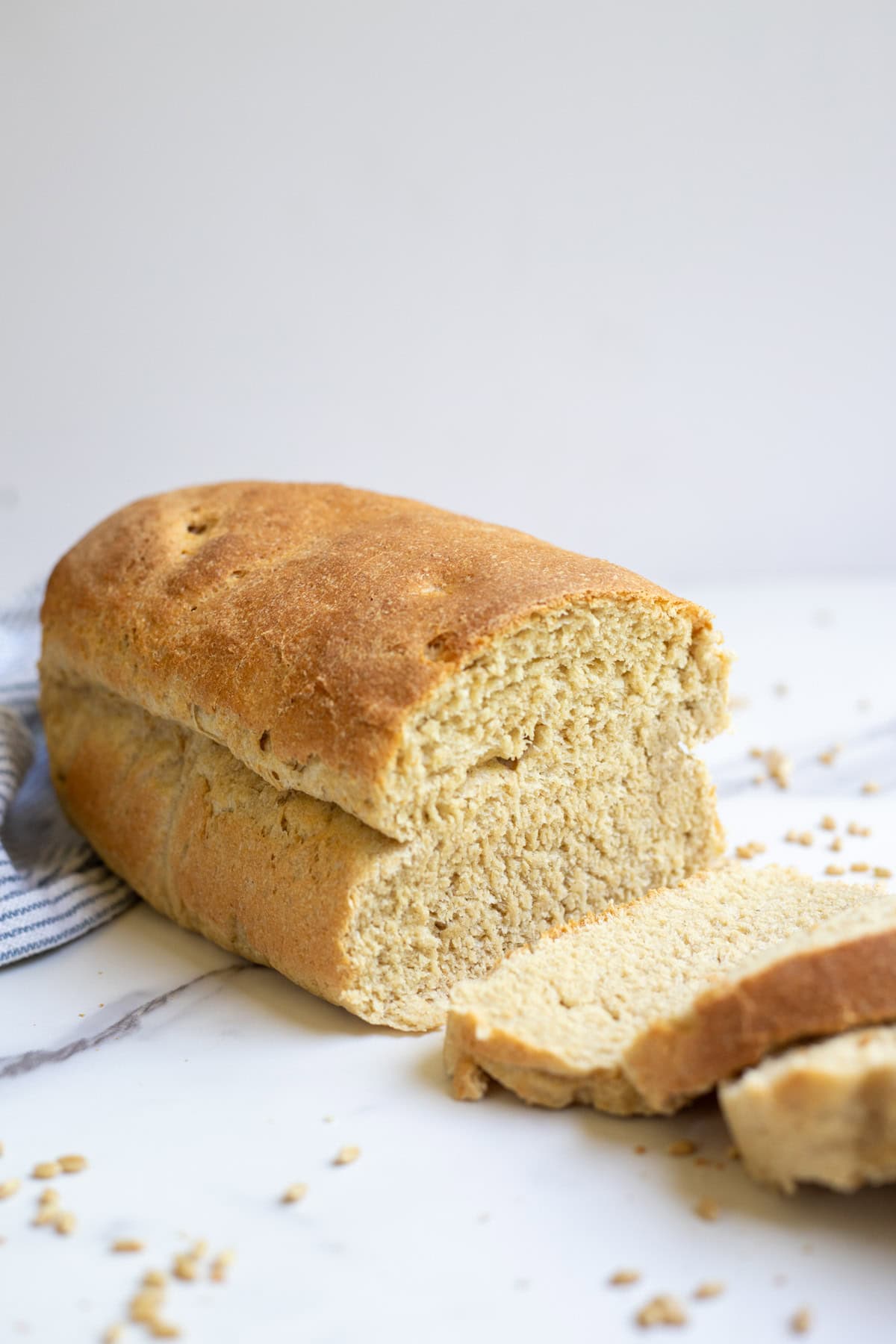
Fresh milled wheat is quickly replacing the other flours in my kitchen. The health benefits of milling my own flour are just too convincing, and the flavor and quality are unmatched, so I’ve been incorporating fresh ground flour whenever and wherever I can.
Commercial flour is often processed, bleached, and fortified with folic acid and other vitamins that were lost in the processing. This affects both flavor and nutrition. And while fortification may sound nice, it is a subject that has become somewhat controversial.
Grinding your own wheat keeps those natural vitamins and minerals intact so that you benefit right from the source as intended.
Additionally, once ground, oxidation begins to decrease the nutrients in the flour. The flour you buy in the store is not fresh and has lost much of its nutritional value at that point.
If you’d like more information on the kinds of grain mills available, the types of grain to consider, and why this is a beneficial practice, I have a separate post on how to mill your flour at home that covers these topics.
You might wonder if this is just an expensive hobby for some people. Really it’s about getting away from the ultra-processed lifestyle and learning the old ways that made for healthier lives. Whole grains that are consumed how they were intended. Flavor that is naturally vibrant and robust, not artificially enhanced.
You’ll find that the extra cost of buying a quality mill and wheat berries pays off pretty quickly. Wheat berries, when stored properly, have a long shelf life. This means you can make flour on demand without worrying about using all those wheat berries within a certain time frame.
Keeping your own grains on hand is a great way to have quality food that will last. If you need some help getting started, read my post on where to buy wheat berries and other bulk grains.
This freshly milled wheat sourdough sandwich bread recipe produces a loaf that smells and tastes incredibly fresh because it is. It’s delicious and perfectly soft when sliced and eaten warm, but also hard to beat toasted and covered in melted butter. The higher protein content and strong gluten networks of hard white wheat turn out the perfect whole wheat flour sandwich loaves.
Milling flour is rewarding and serves my family. So make your own flour and see if it doesn’t bring you great satisfaction!
Why You’ll Love This Recipe
Increased nutrition – Milled at home, fresh flour maintains its bran and germ, which offer increased vitamins and minerals. Store-bought flour is often highly processed, sometimes bleached, and lower in nutrients from oxidation over time.
Deeper flavor – Freshly milled flour has a heightened flavor because it is less processed, retains all parts of the grain, and is ground right before use. The naturally sweet, nutty flavor is amplified all the more when baked.
Easier digestion – Because the bran and germ are preserved, fresh milled flour has more of its nutrients intact. This not only includes vitamins and minerals but also the enzymes that aid in digestion.
Ingredients
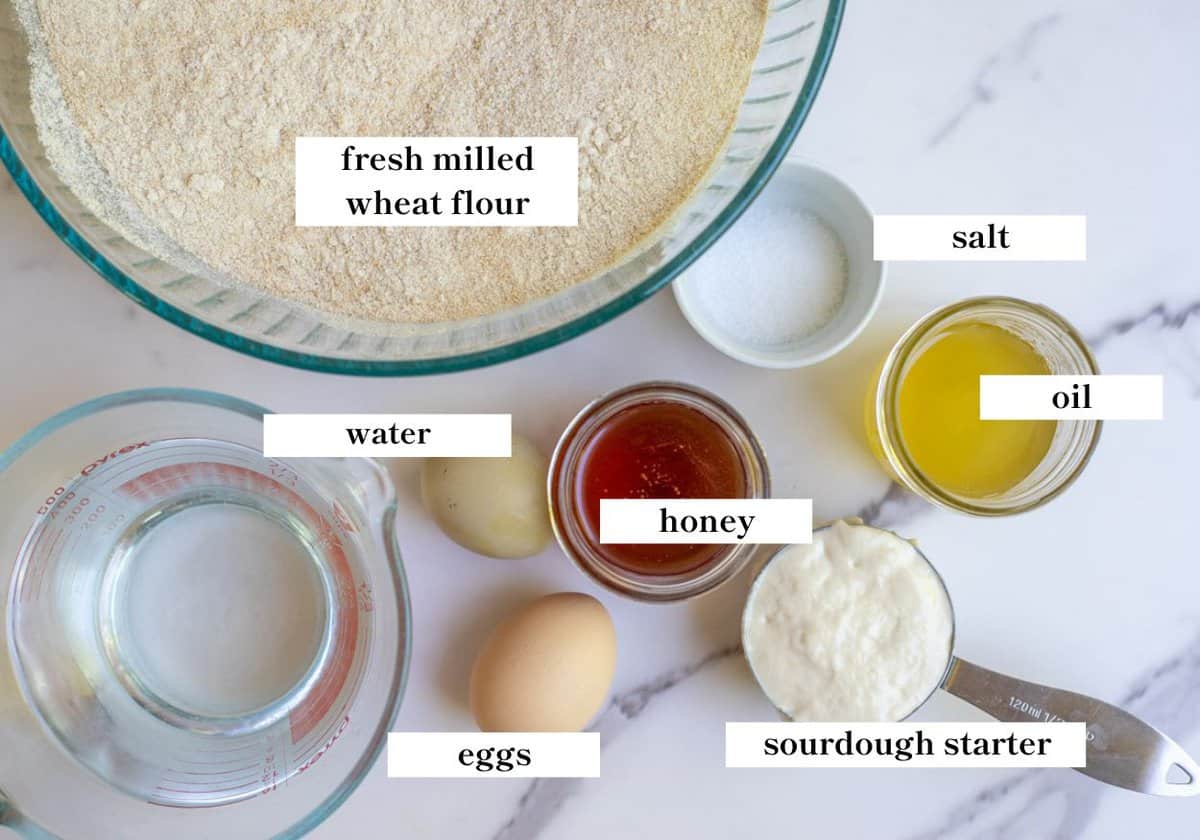
Fresh milled flour – I use hard white wheat for its higher gluten content and better structure. You can use hard red wheat or hard white but avoid soft wheat. Soft wheat has less gluten and is meant for more delicate recipes like fluffy biscuits or chocolate chip cookies.
Active sourdough starter – Recently fed; active and bubbly. Active starter is the leavening agent that gives your loaf of bread its rise.
Water – I always recommend filtered water for best results. The chlorine in tap water can hinder fermentation.
A full ingredient list with exact amounts can be found in the recipe card below.
Tools You May Need
Grain mill – I like my Mockmill, but I’ve also tried the Nutrimill. Here is my post on how the Mockmill and Nutrimill compare.
How to Make Fresh Milled Sourdough Bread
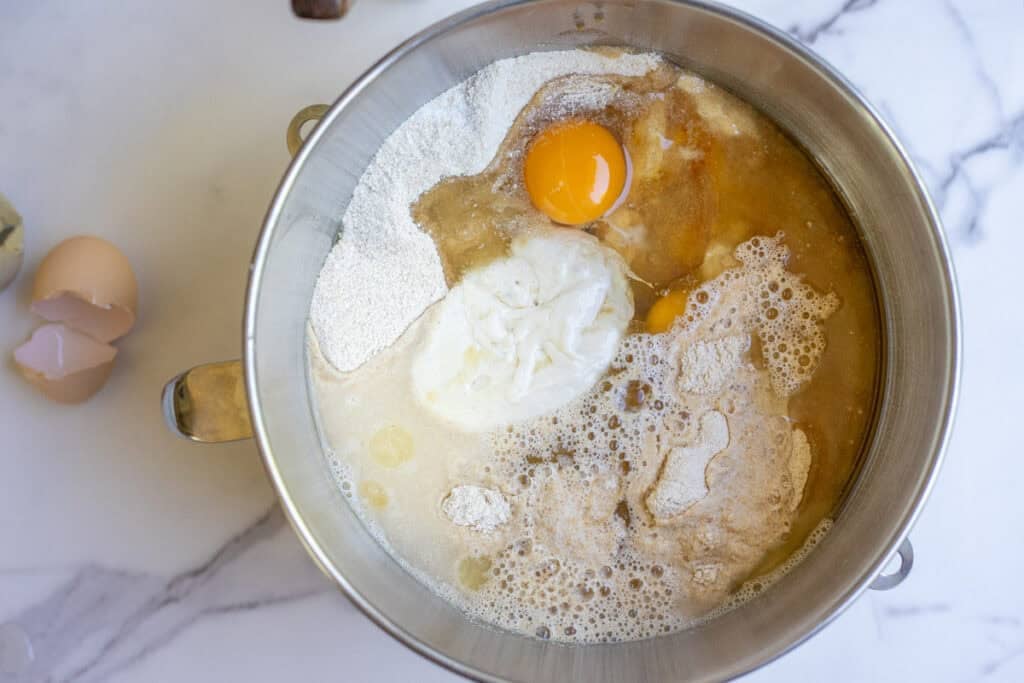
Step 1: Begin when you have a fed, active starter. Add water, oil, honey, salt, eggs, starter, and flour to a large mixing bowl or to the bowl of a stand mixer with a dough hook attachment. Mix by hand or on medium speed until the dough is fully incorporated. Cover and let the dough rest for 30 minutes to fully hydrate the flour.
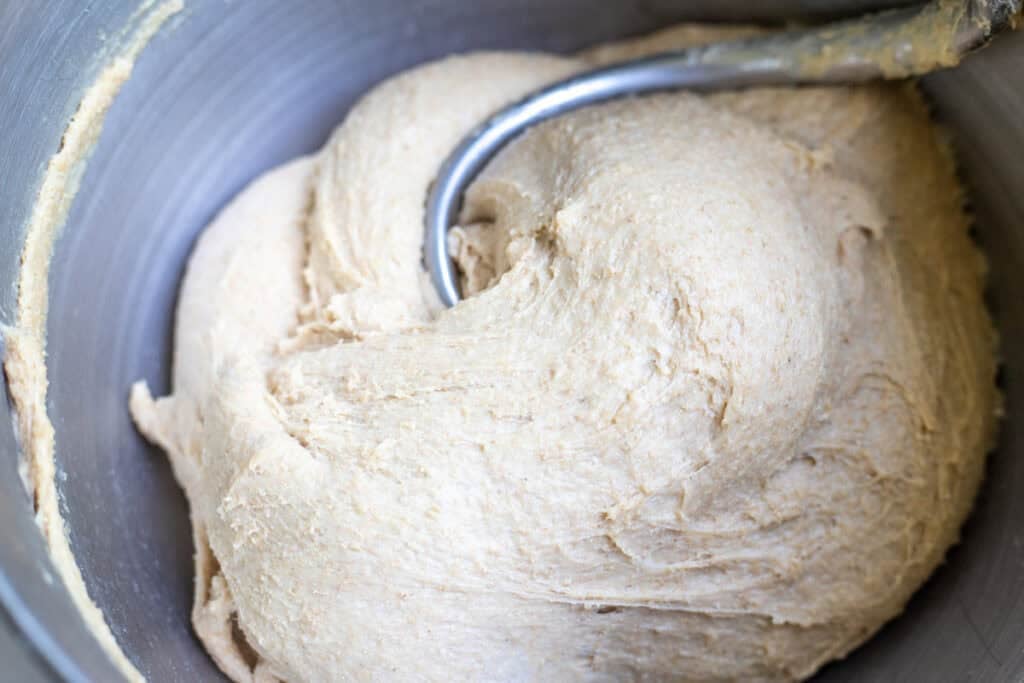
Step 2: If using the mixer, continue on medium-low for 15 – 20 minutes until the dough is smooth and does not stick to the sides of the bowl. If the dough is still too wet and won’t come together, add more flour a little at a time until it does.
Tip: Alternatively, you can begin a series of stretch and folds where you take the dough on one side and pull it up about 6 inches, then fold it over the rest of the dough and press. Turn the bowl a quarter turn and repeat the process 3 – 4 times. This is considered one round. Cover the bowl between rounds, following the schedule below.
- First 3 stretch and folds, every 15 minutes.
- Last 3 stretch and folds, every 30 minutes.
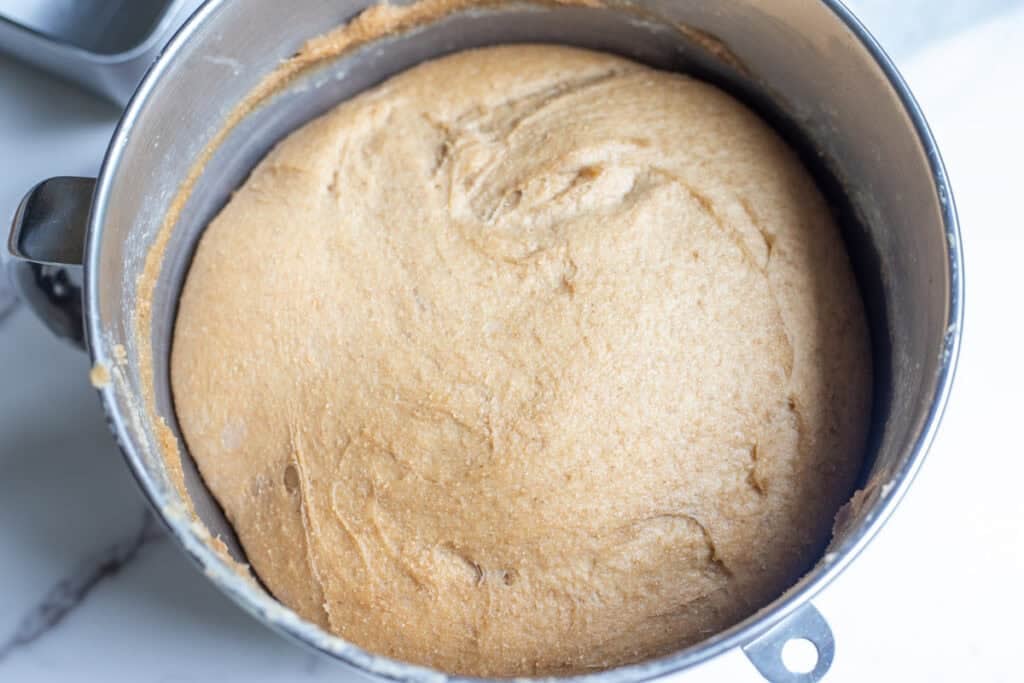
Step 3: Cover the bowl with a damp tea towel and set it in a warm place for 10-12 hours for the bulk fermentation.
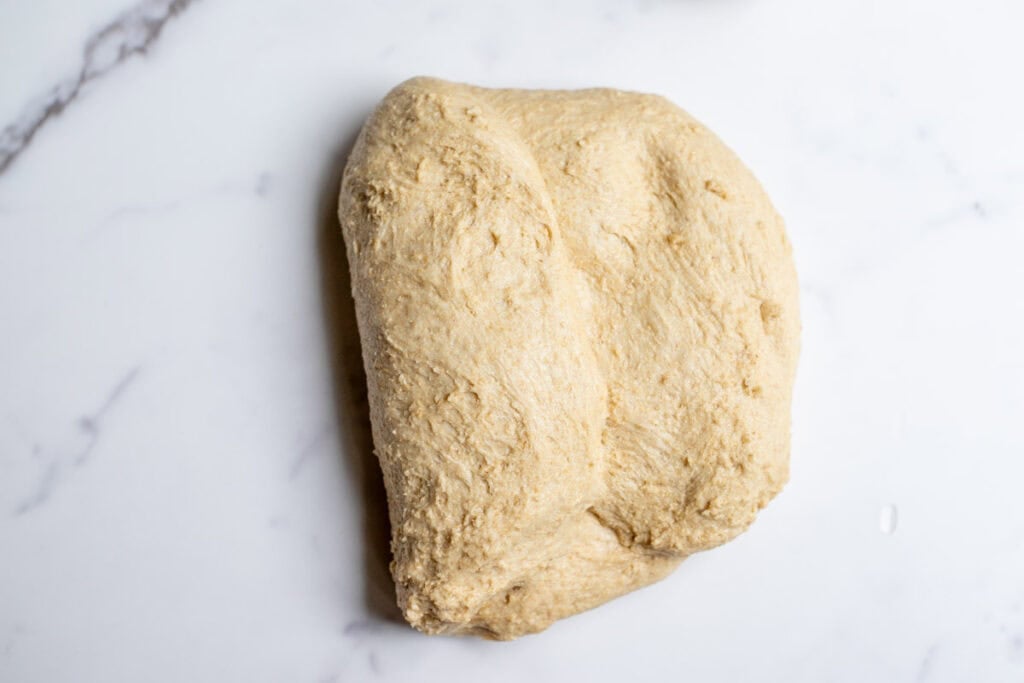
Step 4: After this first rise, divide the bread dough in half. Shape each half for loaf pans by rolling it out into a loose rectangle, then rolling it back up to fit.
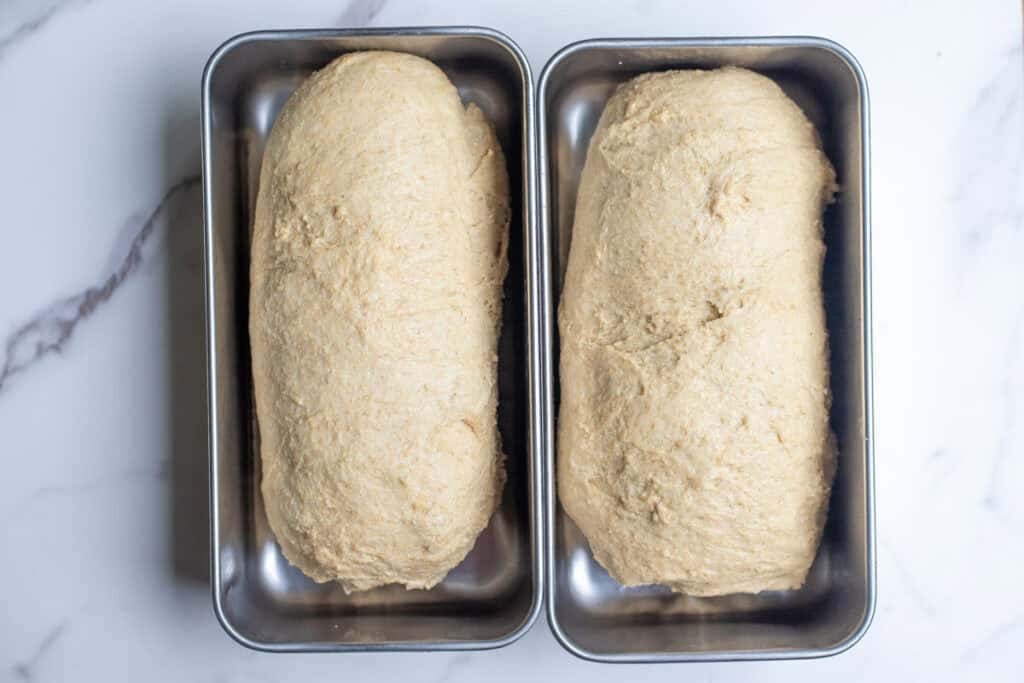
Step 5: Add the dough to loaf pans that are greased or lined with parchment paper. Let the dough rise in a warm place a second time, for 2-4 hours, or until doubled in size.
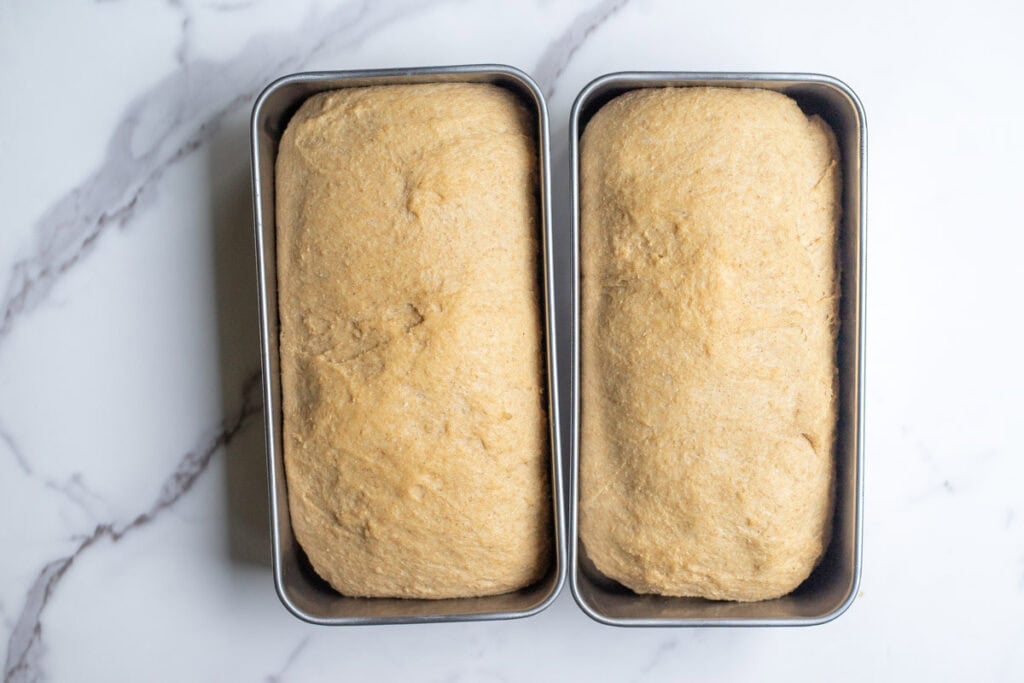
Step 6: Once doubled in size, preheat the oven to 350 degrees Fahrenheit. If you want to add an optional egg wash, do so now. Bake for 30-40 minutes or until golden on top. Allow to cool completely before slicing.
Tips
- The windowpane test is when you stretch a small amount of dough between four fingers. If you can stretch it apart thin enough to see through, the dough is ready. if it breaks apart, not enough gluten formation has happened.
- The ingredients for two loaves may be too much for a standard mixer to handle. You can halve the recipe for your mixer, or you can mix the full recipe by hand and use the stretch and fold method.
- For quicker fermentation, keep your dough near a heat source like a wood burner in the winter, or in a sunny window in the summer. Other common places are the top of cabinets or on top of the refrigerator.
- Don’t over ferment the dough. It will turn into a sloppy mess that won’t rise well. If you need more time, cover the dough and place it in the refrigerator to wait.
- If you mill more flour than you end up using, store the extra flour in an airtight container in a cool, dark place. Keeping it in the fridge or freezer will extend its life. Use within 6 to 12 months.
Recipe FAQs
Leftover bread may be stored in an airtight container at room temperature for up to five days. Once the bread has fully cooled, you can also store it in freezer-safe bags or containers and freeze for 3-6 months.
Yes, it is considered to be a healthier option because it is not processed like the flour from the grocery store. Freshly milled flour retains all of its whole grain components, which preserves the natural vitamins and minerals.
Yes, you can. Whole grain flour ferments rapidly in a sourdough starter, with the natural yeast and good bacteria feasting on the extra nutrition of milled wheat berries, bran and all.
They need more water because of the presence of the bran and germ, which absorb more water. Regular white flour is just the endosperm of the wheat grain, which requires less water.
Whole grains require more kneading and sourdough requires lots of fermentation time. Neglecting either of these will affect the density and texture. If you are trying to speed up the process, don’t skip steps. Instead, you can use warm water when making the dough and keep it in a warm location for the fermentation.
Baker’s Timeline
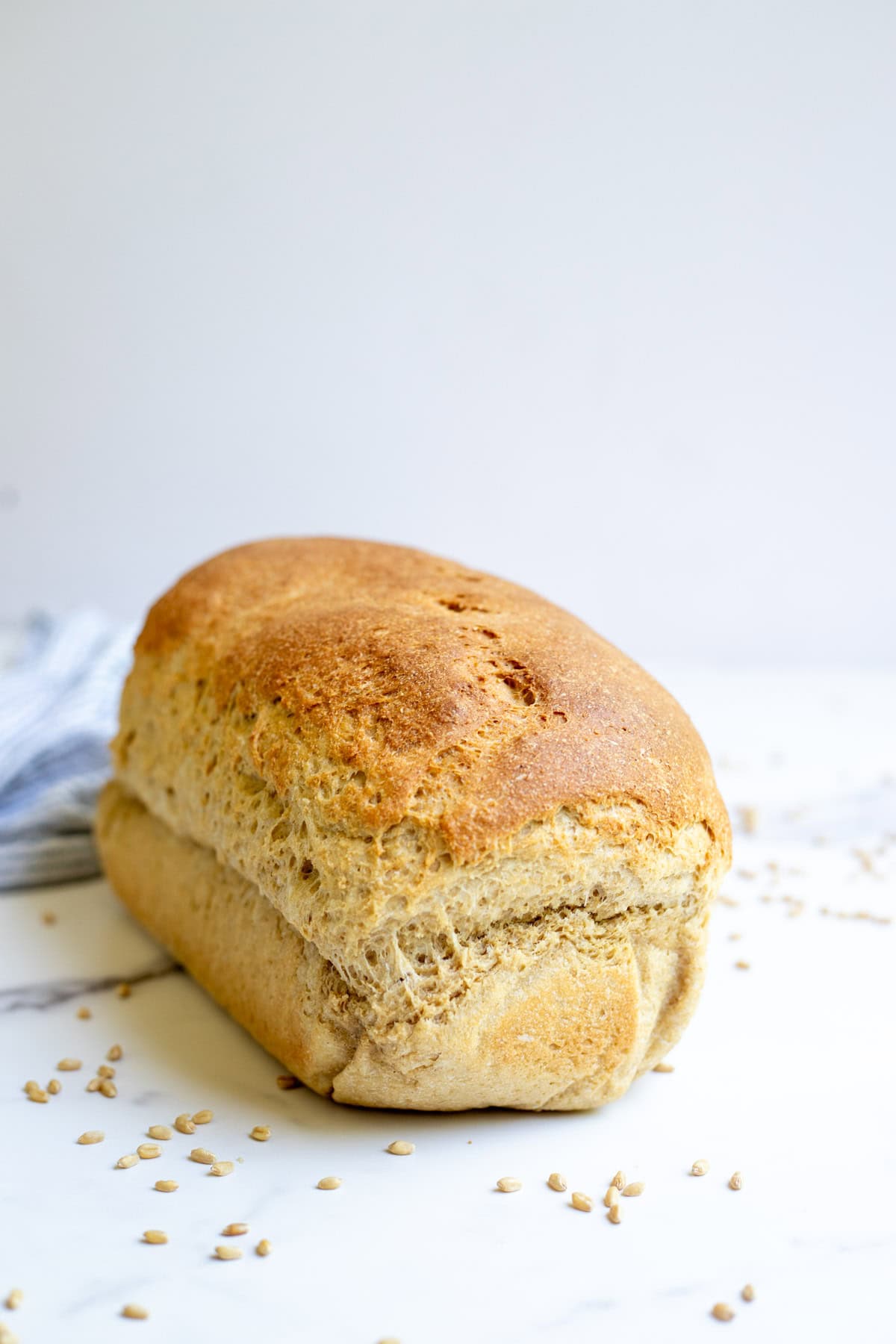
Day One
1:00 pm: Feed sourdough starter.
5:00 pm: When the starter is peaked, mix all dough ingredients, then let rest for 30 minutes.
5:45 pm: Begin the stretch and fold process. First 3 stretch and folds – every 15 minutes. Last 3 stretch and folds – every 30 minutes.
8:00 pm: Cover with a damp towel and allow the dough to bulk ferment for 10 – 12 hours.
Day Two
8:00 am: Shape dough into two loaves.
8:30 am: Cover and let rise for 2 – 4 hours until doubled.
10:30 am: Bake for 30 – 40 minutes, then cool.
More Sourdough Recipes from the Farmhouse
- Easy Kamut Bread
- Soft Multigrain Sourdough Bread
- Spelt Sourdough Bread
- Easy Einkorn Sandwich Bread
- Whole Wheat Sourdough Dinner Rolls
If you try this recipe and love it, I would love it if you could come back and give it 5 stars! Tag me on Instagram @farmhouseonboone.
Fresh Milled Sourdough Sandwich Bread
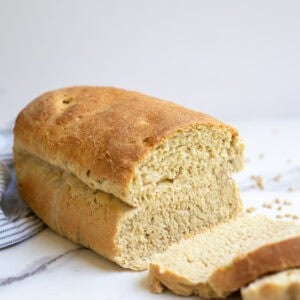
Equipment
- Grain mill
Ingredients
- 2 1/4 cups water, 531g
- 1/2 cup oil, 112g
- 1/2 cup honey, 168g
- 1 tablespoon salt, 17g
- 2 eggs
- 1/2 cup active starter, 113g
- 7 cups fresh milled flour, 1,050g I use hard white wheat
Instructions
- Begin when you have a fed, active starter. Add water, oil, honey, salt, eggs, starter, and flour to a large mixing bowl or to the bowl of a stand mixer with a dough hook attachment.
- Mix by hand or on medium speed until the dough is fully incorporated. Cover and let the dough rest for 30 minutes to fully hydrate the flour.
- If using the mixer, continue on medium-low for 15 – 20 minutes until the dough is smooth and does not stick to the sides of the bowl. It should pass the windowpane test. If the dough is wet, add a some flour a little bit at a time.
- Alternatively, you can begin a series of stretch and folds where you take the dough on one side and pull it up about 6 inches, then fold it over the rest of the dough and press. Turn the bowl a quarter turn and repeat the process 3 – 4 times. This is considered one round. Cover the bowl between rounds, following the schedule below.
- First 3 stretch and folds, every 15 minutes. Last 3 stretch and folds, every 30 minutes.
- For all kneading methods, when kneading is complete, cover the bowl with a damp tea towel and set it in a warm place for 10 – 12 hours for the bulk fermentation.
- After this first rise, divide the bread dough in half. Shape each half for loaf pans by rolling it out into a loose rectangle, then rolling it back up to fit.
- Add the dough to loaf pans that are greased or lined with parchment paper. Let the dough rise in a warm place a second time, for 2 – 4 hours, or until doubled in size.
- Preheat the oven to 350 degrees Fahrenheit. If you want to add an optional egg wash, do so now. Bake for 30 – 40 minutes or until golden on top. Allow to cool completely before slicing.
Notes
- The ingredients for two loaves may be too much for a standard mixer to handle. You can make half of the recipe for one loaf if you are worried about overheating your mixer or just mix by hand and use the stretch and fold method.
- Please double-check amounts when using the multiplying feature in the recipe card.
- If you are looking for gram measurements, toggle to the “metric” version in the recipe card.
- The windowpane test is when you stretch a small amount of dough between four fingers. If you can stretch it apart thin enough to see through, the dough is ready. if it breaks apart, not enough gluten formation has happened.
- Don’t over ferment the dough. It will turn into a sloppy mess that won’t rise well.
Nutrition
Nutrition information is automatically calculated, so should only be used as an approximation.
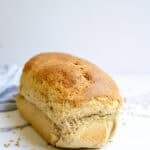
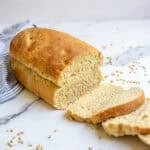
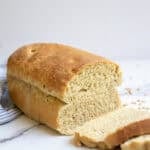


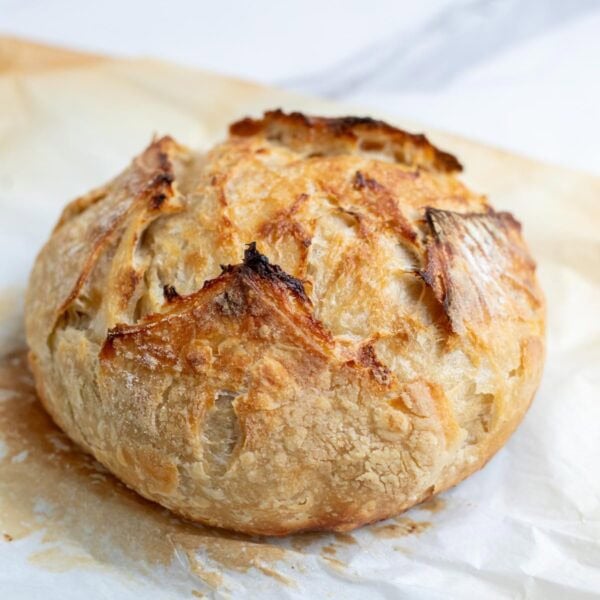
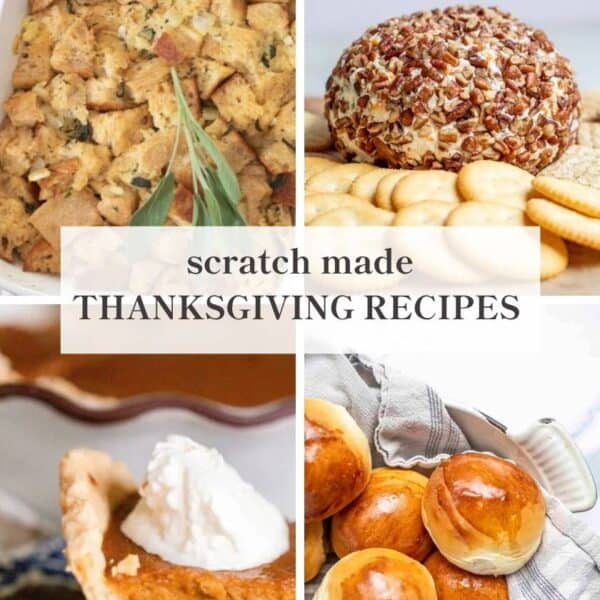






My whole family loves the taste and texture of this yummy bread! I have been making it with 2/3 fresh milled spelt, and 1/3 fresh milled rye.
Despite the amazing flavour, I am definitely doing something wrong. I am following the recipe exactly as written. Baking the bread takes 50 minutes or more for sure, and the loaves split along the side. Even when I use the bread lame to cut a slit on the top, it fills in and the loaf comes out with the sides split. any ideas?
I would say the dough hasn’t fermented long enough then.
Thank you Lise, I have been trying freshly milled flower recipes without success. I was so happy when I saw my first rise after the first fermentation period and then again after the second fermentation. I made two perfect soft and fluffy loaves of bread with freshly milled flour and to top it off – sourdough as well. I am so grateful for this wonderful recipe. My son loved the bread and one loaf very quickly disappeared! So grateful.
This bread is amazing and I make it all the time!!
Hi! I’d like to make this recipe but divide it into 4 small loaves. What is recommendation for baking time?